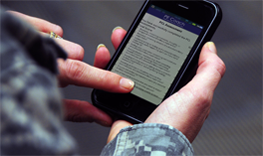T2 How-to: Using Mobile Apps in Behavioral Health Practice - T2 Mood Tracker
Here at T2 we’re working on helping those who work directly with patients make better use of our mobile applications. A few weeks ago, Dr. Christina Armstrong spoke about some general tips on using mobile apps in behavioral health treatment (if you haven’t read it, it’s a great place to start).
I’d like to start a more focused series on how specific mobile apps can be used in the context of behavioral health treatment – starting with one of our more popular applications, T2 Mood Tracker. If you aren’t familiar with T2 Mood Tracker, we have a nice overview of it on T2health website.
In terms of clinical practice, there are two elements that you should focus on: custom rating scales and reports.
Custom Rating Scales – Although T2 Mood Tracker has pre-made rating scales for anxiety, depression, post-traumatic stress and others, you can work with patients to create custom scales that fit their needs or understanding of the problems they’re having. By working with their own words, as opposed to “psychobabble,” patients can get more engaged with treatment.
Another way to use these custom scales is in gauging reactions to medications. By creating custom scales, you can help monitor how patients are responding to new medications, dosage changes and tapering off.
Reports – We developed reports in T2 Mood Tracker as an easy way for patients to keep an eye on their data over time. One of the ways they can do this is by exporting these reports in an easy to read PDF format. This gives them not only a visualization of their actual data but trend lines that shows the overall direction of what they are tracking.
Patients can either print these PDF reports or email them to you directly. In this way, you can stay connected with patients between sessions, or get an update on their mood before the appointment even starts.
Stay tuned for more T2 How-to articles on many of our other applications.









